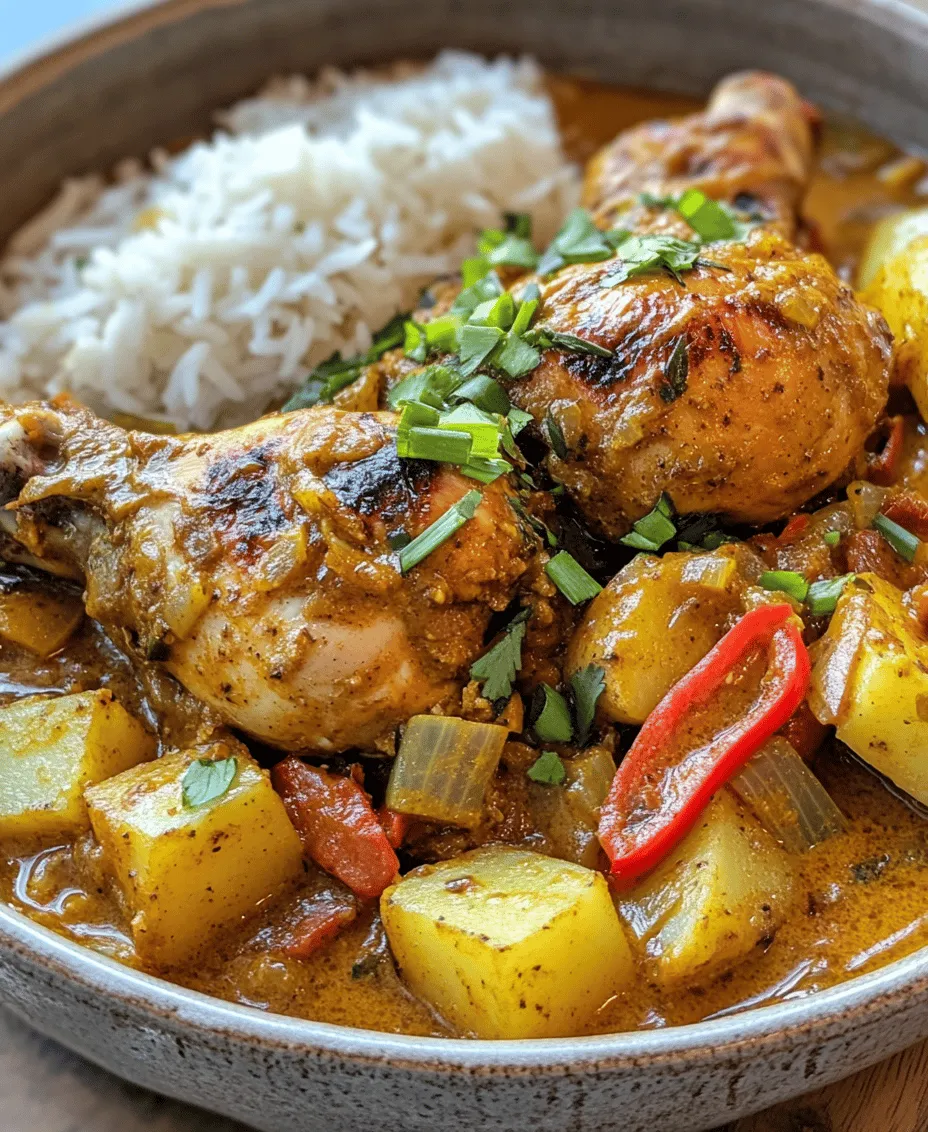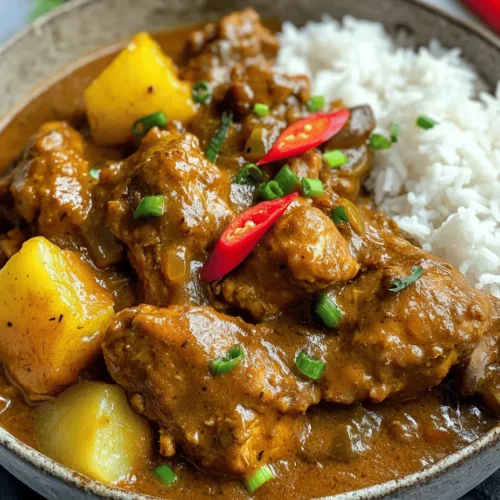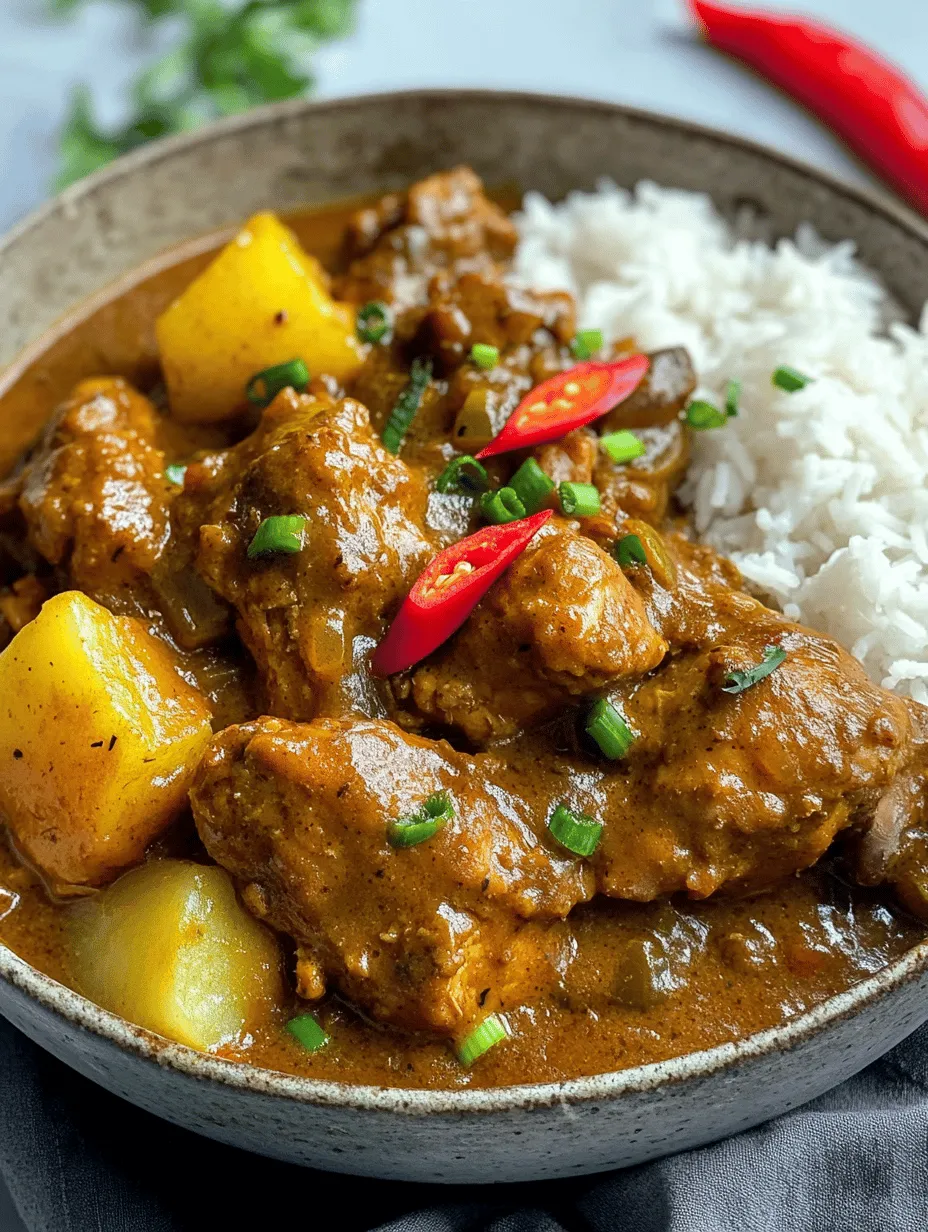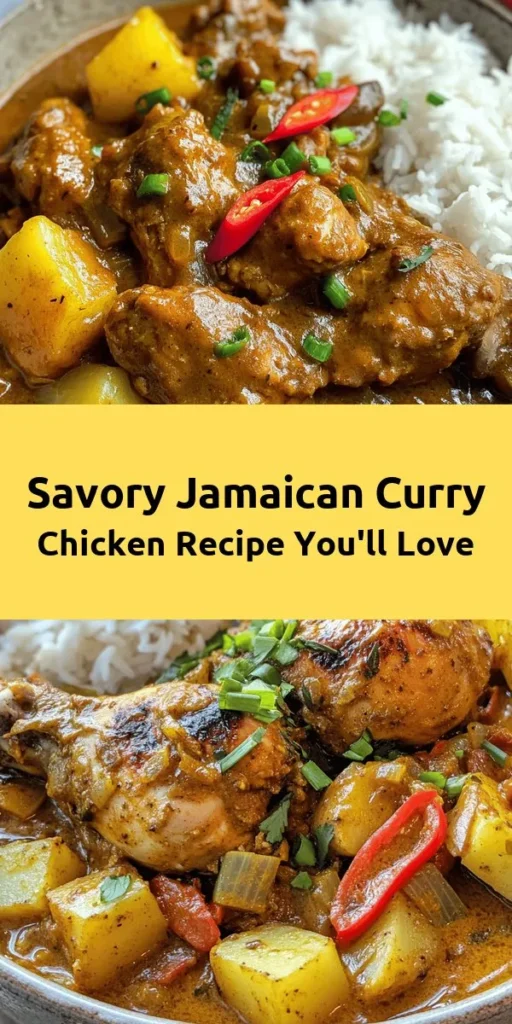Introduction to Authentic Jamaican Curry Chicken
When it comes to Caribbean cuisine, few dishes are as beloved and celebrated as Jamaican Curry Chicken. This vibrant and aromatic dish not only showcases the rich flavors of the island but also reflects the deep cultural heritage of Jamaica. With its roots deeply embedded in the fusion of Indian spices and traditional Jamaican cooking, Curry Chicken stands as a symbol of the island’s culinary history and diversity.
Jamaican Curry Chicken is more than just a meal; it’s an experience that invites you to explore the tropical flavors and spices that characterize Jamaican cooking. The dish is known for its warm, inviting aroma and a perfect balance of spices, making it a staple in many Jamaican households. Whether served at family gatherings, special occasions, or simply as a comforting weeknight dinner, this dish encapsulates the essence of Jamaican hospitality.
In this article, we will guide you through the process of creating authentic Jamaican Curry Chicken from scratch. We will explore the rich flavors of this dish, the essential role of each ingredient, and the cooking techniques that bring this culinary masterpiece to life. Prepare yourself for a delicious culinary journey that promises to awaken your taste buds while celebrating the vibrant spirit of Jamaican cuisine.
Exploring the Ingredients of Jamaican Curry Chicken
The foundation of any great dish lies in its ingredients. When it comes to Jamaican Curry Chicken, each component plays a vital role in creating the rich and complex flavors that define this dish. Understanding these ingredients not only enhances your cooking experience but also deepens your appreciation for the dish. Let’s delve into the key components that come together to create this authentic Jamaican classic.
Overview of Jamaican Curry Powder
At the heart of Jamaican Curry Chicken is Jamaican curry powder, a unique blend of spices that distinguishes it from other types of curry. Unlike Indian curry powder, Jamaican curry powder typically contains a higher proportion of turmeric, which gives it a vibrant yellow color, along with spices such as coriander, cumin, and fenugreek. This blend is essential in providing the characteristic flavor profile of Jamaican curry, making it a must-have for your culinary arsenal.
The Role of Allspice in Jamaican Cooking
Allspice, known as “pimento” in Jamaica, is another essential ingredient that adds depth and warmth to the dish. This unique spice, which resembles a combination of cinnamon, nutmeg, and cloves, is a hallmark of Jamaican cuisine. It complements the heat of the curry powder and enhances the overall flavor of the chicken. Using fresh allspice berries or ground allspice in your recipe will elevate the taste and make your dish truly authentic.
Importance of Fresh Ingredients: Onion, Garlic, Ginger, and Scallions
Fresh vegetables and aromatics are crucial for building flavor in Jamaican Curry Chicken. Onions, garlic, and ginger are the trifecta of flavor development in this dish. Onions provide a sweet base, garlic adds a pungent kick, and ginger contributes a warm, zesty note. Scallions, or green onions, bring a mild onion flavor and a pop of color, further enriching the dish.
Using fresh ingredients not only enhances the taste but also ensures that your curry is bursting with nutrition. The combination of these aromatics creates a flavorful base that infuses the chicken with deliciousness during the cooking process.
The Heat of Scotch Bonnet Peppers: A Spice Lover’s Delight
For those who enjoy a bit of heat, Scotch bonnet peppers are essential in Jamaican cooking. These fiery peppers add a distinct flavor and a significant level of heat to the curry. Their fruity undertones complement the spices beautifully, making them perfect for this dish. While the pepper’s heat can be intense, it can be adjusted according to your spice tolerance. Remember to handle these peppers with care—use gloves and wash your hands thoroughly after handling them to avoid any irritation.
Potatoes: Adding Texture and Flavor
Potatoes are often included in Jamaican Curry Chicken to add heartiness and texture to the dish. As they cook, they absorb the rich flavors of the curry, making them a comforting addition. You can use any variety of potatoes, but yellow or red potatoes work particularly well due to their ability to hold their shape during cooking. Cut them into bite-sized pieces and add them to the pot to enhance the overall texture and heartiness of the curry.
Coconut Milk: The Creamy Element of the Dish
Coconut milk is another key ingredient that adds richness and creaminess to Jamaican Curry Chicken. It balances the spices and heat, resulting in a well-rounded dish that is both comforting and satisfying. The addition of coconut milk not only contributes to the flavor but also gives the curry a luscious, creamy texture that beautifully coats the chicken and potatoes.
The Significance of Fresh Thyme
In Jamaican cuisine, fresh thyme is often used as a herb to enhance flavor. Its earthy notes pair perfectly with the spices in the curry and contribute to the overall freshness of the dish. Using fresh thyme instead of dried thyme is recommended, as it provides a more robust flavor. Simply strip the leaves from the stems and toss them in during the cooking process for maximum flavor impact.
The Zest of Lime: Brightening the Flavor Profile
Finally, the addition of lime juice at the end of cooking brightens the entire dish. Lime adds a refreshing acidity that cuts through the richness of the curry and enhances the overall flavor profile. It’s a simple yet impactful addition that transforms the dish from good to great. Always use fresh lime juice for the best results; the flavor difference is unmistakable.
Preparing the Chicken: Marination Techniques
Marination is a crucial step in developing the flavors of your Jamaican Curry Chicken. Properly marinating the chicken ensures that the spices penetrate the meat, resulting in a dish that is bursting with flavor. In this section, we will explore the importance of marinating, the ideal duration for marination, and tips to ensure even coating and flavor penetration.
The Impact of Marination on Flavor
Marinating chicken is not just about seasoning; it’s a transformative process that enhances the overall taste and tenderness of the meat. When chicken is marinated, the acid in the marinade helps break down the proteins, resulting in a more tender texture. Additionally, the spices and aromatics used in the marinade infuse the meat with flavor, ensuring that every bite is delicious.
For Jamaican Curry Chicken, it’s essential to allow the chicken to marinate for at least a few hours, if not overnight. This allows the spices to penetrate deeply and ensures that the chicken is packed with flavor throughout.
How Long Should You Marinate?
The ideal marination time can vary based on personal preference and the type of chicken used. For optimal flavor, marinating the chicken for at least 2 to 4 hours is recommended. However, for best results, aim for overnight marination. This extended time allows the chicken to fully absorb the flavors of the spices, resulting in a more flavorful dish.
If you are short on time, even a quick 30-minute marinade can make a difference, but keep in mind that the longer you marinate, the more intense the flavors will be. When marinating, always cover the chicken and refrigerate to prevent bacterial growth.
Tips for Ensuring Even Coating and Flavor Penetration
To achieve an even coating and ensure that the flavors penetrate every piece of chicken, follow these tips:
1. Cut the Chicken into Smaller Pieces: If using bone-in chicken, consider cutting it into smaller pieces. This increases the surface area for the marinade to adhere to and allows for quicker flavor absorption.
2. Use a Ziploc Bag or Bowl: Place the chicken in a Ziploc bag or a bowl with a lid. If using a bag, make sure to remove as much air as possible before sealing. This allows the marinade to evenly coat the chicken and reduces the risk of spills.
3. Massage the Marinade into the Chicken: After adding the marinade, use your hands to massage the spices into the chicken. This ensures that every piece is well-coated and helps the flavors penetrate deeper.
4. Turn Occasionally: If marinating for an extended period, turn the chicken occasionally to ensure all sides are coated with the marinade. This is particularly important if using a bowl, as the marinade can settle at the bottom.
By following these steps, you’ll ensure your Jamaican Curry Chicken is not only flavorful but also tender and juicy.
Sautéing Aromatics: The Base of the Curry
Creating a solid base for your curry is essential for depth of flavor. The process of sautéing aromatics is where the magic begins, as it sets the stage for the entire dish. In this section, we will outline the process of sautéing key ingredients and how they enhance the overall flavor of the curry.
The Role of Onions in Flavor Development
Onions are often considered the backbone of many dishes, and Jamaican Curry Chicken is no exception. When sautéed, onions release their natural sugars, which caramelize and create a rich, sweet flavor. Begin by heating oil in a large pot or dutch oven over medium heat. Once hot, add the chopped onions and sauté them until they become translucent and slightly caramelized. This process can take about 5 to 7 minutes.
The sweetness of the onions forms the foundation for the curry’s flavor, balancing the spices and heat that will be added later.
Benefits of Adding Scallions and Scotch Bonnet Peppers
After the onions have softened, it’s time to add the scallions and Scotch bonnet peppers. The scallions should be added towards the end of the onion sautéing process to retain their bright flavor and color. Chop them into small pieces and add them to the pot, stirring well.
Next, finely chop or slice the Scotch bonnet peppers and add them to the pot. The amount of pepper used can be adjusted based on your spice preference. Sautéing these ingredients together releases their natural oils and flavors, which will infuse the curry with a delightful aroma.
Achieving the Perfect Aroma: Cooking Techniques
To achieve the perfect aroma, it’s important to control the heat while sautéing your aromatics. Cooking over medium heat allows the onions to caramelize without burning, while also releasing the essential oils from the scallions and Scotch bonnet peppers. Stir the mixture frequently to prevent sticking and ensure even cooking.
Once the aromatics are softened and fragrant, you can then add the marinated chicken to the pot. This is where all the flavors come together, as the chicken begins to brown and absorb the aromatic base you’ve created.
With the aromatics sautéed to perfection, you’re now ready to move on to the next steps in creating your authentic Jamaican Curry Chicken. As we continue this culinary journey, each step will build upon the last, culminating in a dish that truly embodies the essence of Jamaican cooking.

Browning the Chicken: Techniques for Perfect Texture
Searing the chicken is a crucial step in preparing authentic Jamaican curry chicken. This technique not only enhances the flavor but also contributes significantly to the texture of the dish. When done correctly, browning creates a rich, caramelized surface on the chicken that adds depth to the overall flavor of the curry.
The Science Behind Browning Meat
Browning, or the Maillard reaction, occurs when proteins and sugars in the meat react under high heat, producing complex flavors and a golden-brown color. This process is essential for developing a rich base for your curry. It’s important to use a hot pan and to allow the chicken to sear undisturbed for a few minutes before flipping, as this will help achieve that sought-after crust.
Tips for Searing Chicken Without Overcrowding the Pan
One of the most common mistakes when browning chicken is overcrowding the pan. When too much chicken is added at once, the temperature of the pan drops, leading to steaming rather than searing. To prevent this, follow these tips:
1. Work in Batches: If you have a lot of chicken, divide it into smaller portions. This allows each piece to have enough space to brown properly.
2. Use a Heavy-Bottomed Pan: A cast-iron skillet or a Dutch oven retains heat well, which is ideal for achieving a nice sear.
3. Ensure the Pan is Hot: Preheat your pan on medium-high heat and add a small amount of oil before adding the chicken. You should hear a sizzle when the chicken hits the pan.
Balancing Cooking Time for Optimal Results
When browning chicken for curry, aim for a cooking time of about 5-7 minutes per side, depending on the size of the pieces. You want them golden brown but not fully cooked through, as they will continue to cook in the curry. Once browned, remove the chicken from the pan and set it aside, allowing it to rest while you prepare the rest of the dish.
Combining Ingredients: Building the Curry
With the chicken perfectly browned, it’s time to build the curry by combining the remaining ingredients. This step is where the flavors marry, creating the rich, aromatic profile that Jamaican curry chicken is known for.
Importance of Layering Flavors
Layering flavors is a fundamental technique in cooking, especially in a dish like curry. Start by sautéing onions, garlic, and ginger in the same pan you used for the chicken. This allows you to capture the fond (the browned bits stuck to the bottom of the pan), which adds immense flavor. After the aromatics have softened, add your spices—curry powder, allspice, and black pepper—cooking them for a minute to release their oils and enhance their flavors.
How to Properly Combine Potatoes, Coconut Milk, and Broth
Once the spices are fragrant, it’s time to add the potatoes, coconut milk, and chicken broth. To do this effectively:
1. Add the Potatoes: Stir in diced potatoes first, allowing them to soak up the spices before adding the liquids. This helps them absorb flavor as they cook.
2. Incorporate Coconut Milk: Pour in the coconut milk slowly, stirring to combine it smoothly with the spices and potatoes. The creaminess of the coconut milk will balance the heat of the spices.
3. Add Broth: Finally, add chicken broth to the pot, ensuring there’s enough liquid to cover the chicken and potatoes. This will create a luscious sauce for the curry.
The Role of Fresh Thyme in Enhancing Flavor
Fresh thyme is a hallmark of Jamaican cuisine and will elevate your curry chicken significantly. Add a few sprigs of fresh thyme to the pot after incorporating the liquids. Thyme not only enhances the flavor but also infuses the dish with a fragrant aroma as it simmers. For an extra depth of flavor, consider adding a scotch bonnet pepper for a spicy kick—just be sure to adjust according to your heat tolerance.
Simmering the Curry: Cooking Techniques and Timing
Simmering is where the real magic happens in your Jamaican curry chicken. This step allows all the flavors to meld together and the chicken to become tender.
Understanding the Simmering Process
Once all ingredients are combined, bring the mixture to a gentle boil. Then, reduce the heat to low and cover the pot, allowing it to simmer. This slow cooking method is essential for breaking down the chicken and allowing the spices to infuse throughout the dish. Simmer for about 30-40 minutes or until the chicken is tender and the potatoes are cooked through.
How to Know When the Chicken is Done
To check if the chicken is cooked perfectly, use a meat thermometer. The internal temperature should reach 165°F (75°C). Alternatively, you can cut into a piece of chicken; it should be opaque and the juices should run clear. If it’s still pink, continue simmering for a few more minutes.
Adjusting Seasoning: Taste as You Go
As the curry simmers, it’s crucial to taste and adjust the seasoning. The flavors will develop as they cook, so don’t hesitate to add a pinch of salt or a dash of pepper to enhance the dish. This step is vital in achieving a well-balanced curry that suits your palate.
Serving Suggestions for Jamaican Curry Chicken
Serving your Jamaican curry chicken is as important as preparing it. Presentation can elevate the meal, making it not just food, but an experience.
Traditional Accompaniments: Rice and Peas vs. Steamed Rice
In Jamaican culture, curry chicken is traditionally served with rice and peas, which are actually red kidney beans cooked with coconut milk and thyme. This combination provides a satisfying contrast to the spicy curry. However, if you prefer, steamed white rice can also work well as a neutral base to soak up the rich curry sauce.
Garnishing Ideas to Enhance Presentation
To make your dish visually appealing, consider garnishing it with fresh herbs. Chopped green onions or extra sprigs of thyme can add a pop of color. A sprinkle of freshly ground black pepper can also enhance the look of your curry.
Cultural Significance of Serving Techniques
In Jamaica, food is often a communal affair. Serving your curry chicken in a large bowl at the center of the table encourages sharing and conversation. Consider pairing it with other traditional dishes like fried plantains or coleslaw for a complete meal that reflects Caribbean hospitality.
Conclusion: Savoring Authentic Jamaican Curry Chicken
Creating authentic Jamaican curry chicken at home is not just about following a recipe; it’s about embracing the flavors and traditions of Jamaican culture. With fresh ingredients, proper techniques, and a bit of patience, you can bring a taste of Jamaica to your dining table. This dish is not merely a meal but a celebration of heritage, community, and the joy of cooking.
As you savor each bite, remember that you’re partaking in a culinary tradition that spans generations. Enjoy your culinary adventure, and let the delightful flavors of Jamaican curry chicken inspire you to explore more of what Caribbean cuisine has to offer. Each scoop of tender chicken and aromatic sauce will transport you to the vibrant streets of Jamaica, making every meal a joyful occasion.



